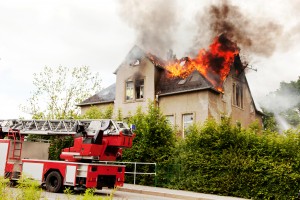Home Fire Safety Tips
May 15th, 2020
Unfortunately, there are over 11,000 house fires each year in Australia, many of which are preventable. Prevention is key, but being prepared is equally important, so we’ve put together some home fire safety tips to keep you and your belongings safe.
What are the top causes of house fires?
 While house fires statistically increase in the winter months, across the space of a year, most preventable fires start in the kitchen.
While house fires statistically increase in the winter months, across the space of a year, most preventable fires start in the kitchen.
The main causes of house fires are:
- Unattended cooking or stove left on when not in use.
- Faulty appliances and electrical faults.
- Heating – including heaters and open fires.
- Curious children.
10 tips to prevent a house fire
- Never leave cooking unattended (indoors or out).
- Ensure that portable heaters are positioned at least 1m from anything that can catch fire (such as curtains, bedding and toys) and never place clothing on or close by to warm or dry.
- Take extra care when reusing stored items such as electric blankets and heaters. Check the cords for any signs of fraying.
- Be careful not to overload power points. Where possible install more power points, or increase to a 4 plug power point so as not to overload the power point with powerboards and double adaptors.
- Check to see if your meter box has a safety switch – especially in older homes. Safety switches protect people from electrocution and fire. They monitor the movement of current through electrical wiring, and disconnect the supply of electricity when it detects differences or imbalances.
- Ensure lighters and matches are out of reach of children.
- Clean the lint filter of your clothes dryer every time you use it and never leave it on when you leave home.
- Never leave open flames unattended, including candles and oil burners, and ensure any log fires are extinguished before going to bed or leaving the house.
- Never smoke in bed.
- Familiarise yourself with the different classes of fire. There are very different approaches to extinguishing each class of fire (ie oil vs electrical fire) and you can put yourself at risk if you use the incorrect method.
Smoke alarms provide early detection of a fire in the home and can save your life. Install smoke alarms on each level of your home and ensure you have an adequate number for the size and layout of your house. Test the battery monthly, dust them bi-annually and replace batteries annually.
Escaping a house fire
Allianz reported that in Australia over 50 deaths a year are caused by accidental house fires. In the unfortunate event that your home catches on fire, it is crucial that you know how to exit quickly and safely. Fire departments across Australia are promoting Get Out, Stay Out and Call Triple Zero (000).
Fire Plan
Each state fire department has tips and resources to assist you in developing a fire plan. Test this plan with your family. Make sure they know what to and which exits to use depending on where the fire is located.
Ensuring accessible exits
Never deadlock doors while you are at home. If it is your only option to lock your door, keep your key accessible. You can read more on safety locking tips for security doors in our blog Door Lock Safety Tips.
Where necessary, install a Fire and Emergency Escape Screen to give you an additional exit in case access to your doors are restricted by flames or heavy smoke. This is especially important for homes with window grilles or fixed security screens on multiple windows. Fire & Emergency Escape Screens allow for a quick and keyless escape. All you need to do is pull the lever and open the screen. You can read more on this in our blog, “How Can a Fire & Emergency Escape Screen Save Your Life?”
Useful links and resources
Creating a fire plan https://www.fire.nsw.gov.au/page.php?id=289
Fire safety checklist www.cfa.vic.gov.au/plan-prepare/home-fire-safety-checklist
Fire & Emergency Escape Screens www.commandex.com.au/products/fire-and-emergency-escape-security-screens/
